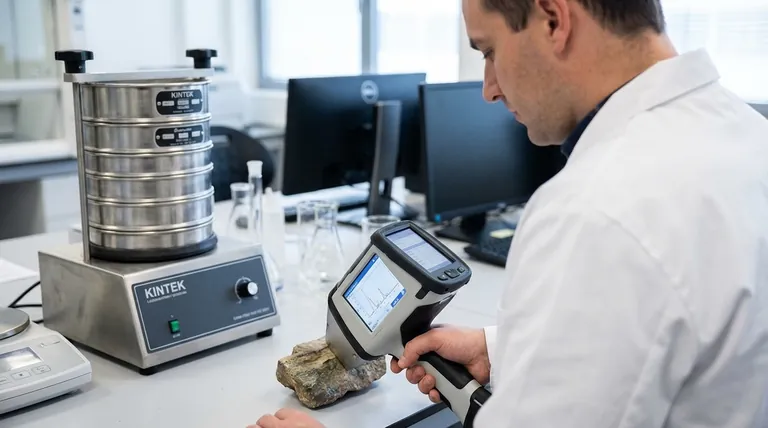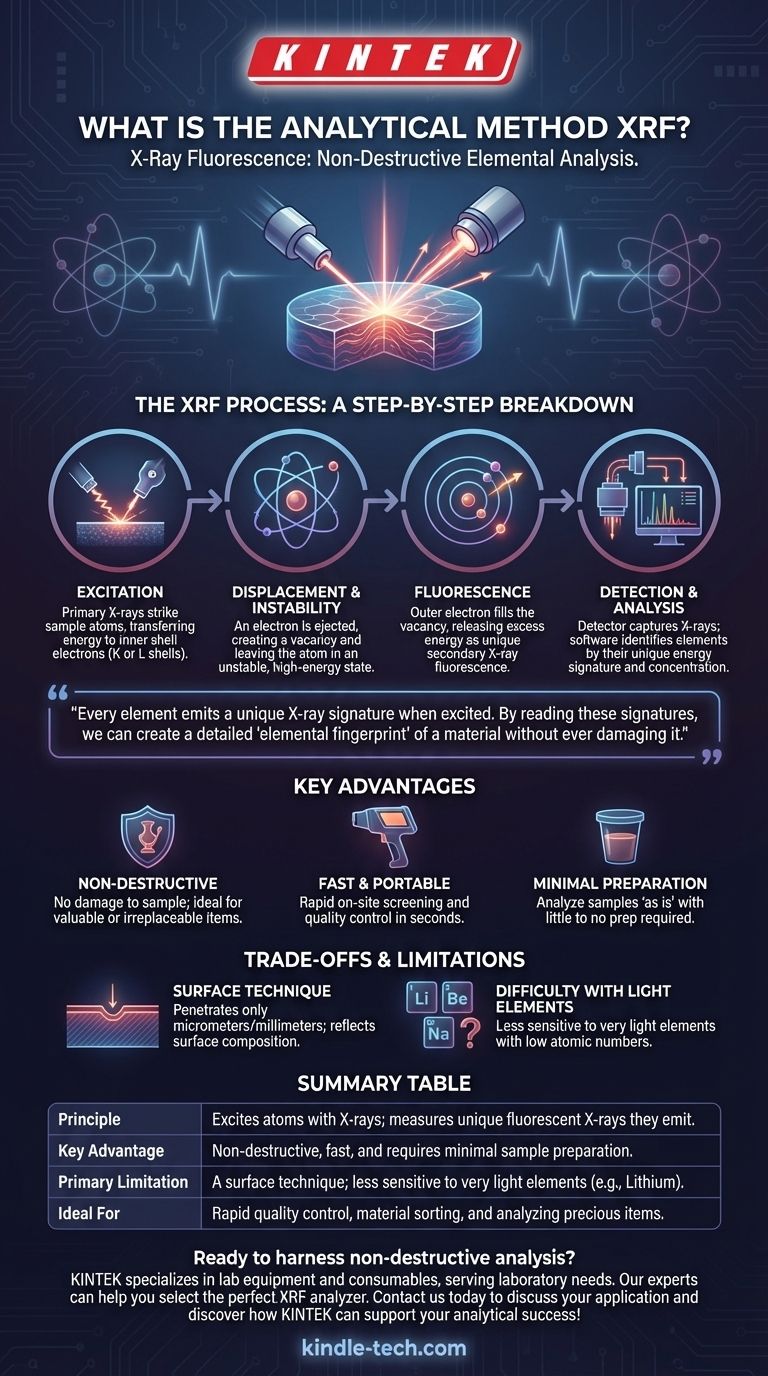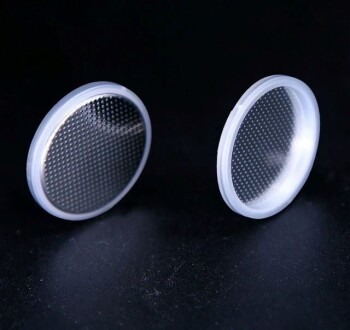Nella sua essenza, la Fluorescenza a Raggi X (XRF) è una tecnica analitica non distruttiva utilizzata per determinare la composizione elementare dei materiali. Funziona bombardando un campione con raggi X ad alta energia, che inducono gli elementi presenti nel campione a emettere i propri raggi X "fluorescenti" caratteristici. Rilevando e misurando questi raggi X secondari, un analizzatore XRF può identificare quali elementi sono presenti e in quali quantità.
Il principio centrale dell'XRF è che ogni elemento emette una firma a raggi X unica quando viene eccitato. Leggendo queste firme, possiamo creare un'"impronta elementare" dettagliata di un materiale senza mai danneggiarlo.

Il Processo XRF: Una Scomposizione Passo Dopo Passo
Per comprendere veramente l'XRF, dobbiamo esaminare le quattro fasi distinte che si verificano in rapida successione all'interno dell'analizzatore. L'intero processo, dall'eccitazione al risultato, viene spesso completato in pochi secondi.
Fase 1: Eccitazione
Il processo inizia quando lo strumento XRF spara un fascio primario di raggi X sulla superficie del campione.
Questo fascio in arrivo è composto da fotoni ad alta energia. Quando questi fotoni colpiscono gli atomi all'interno del campione, trasferiscono la loro energia agli elettroni negli orbitali più interni (tipicamente gli orbitali K o L).
Fase 2: Spostamento e Instabilità
Se il raggio X primario ha energia sufficiente, espellerà un elettrone dal suo guscio interno, espellendolo completamente dall'atomo.
Questo evento crea una vacanza, o "lacuna", nel guscio elettronico, lasciando l'atomo in uno stato instabile e ad alta energia. L'atomo cerca immediatamente di tornare a una configurazione a energia più bassa e stabile.
Fase 3: Fluorescenza
Per riottenere stabilità, un elettrone da un guscio esterno a energia più alta scende per riempire la vacanza nel guscio interno a energia più bassa.
Mentre questo elettrone si sposta da uno stato ad alta energia a uno più basso, rilascia l'energia in eccesso sotto forma di un raggio X secondario. Questa emissione è nota come fluorescenza a raggi X.
Fase 4: Rilevamento e Analisi
L'energia di questo raggio X fluorescente emesso è unica per l'elemento da cui ha avuto origine. È un'impronta diretta di quello specifico atomo.
Un rilevatore di raggi X all'interno dell'analizzatore cattura questi raggi X secondari e li conta. Il software dello strumento elabora quindi questi dati, identificando ciascun elemento tramite la sua firma energetica caratteristica e determinandone la concentrazione in base all'intensità del segnale.
Vantaggi Chiave del Metodo XRF
I principi alla base dell'XRF gli conferiscono diversi vantaggi significativi che lo rendono un metodo preferito in molti settori, dalla geologia e l'estrazione mineraria alla produzione e al riciclo.
È Non Distruttivo
Forse il vantaggio più cruciale dell'XRF è che non danneggia il campione. Il fascio di raggi X eccita gli atomi ma non altera le proprietà fisiche o chimiche del materiale. Ciò è essenziale per l'analisi di oggetti di valore o insostituibili, come manufatti storici, gioielli o componenti critici di produzione.
È Veloce e Portatile
Gli analizzatori XRF moderni, in particolare i modelli portatili, possono fornire un'analisi elementare accurata in pochi secondi. Ciò consente un rapido screening in loco e un controllo qualità senza la necessità di inviare campioni a un laboratorio, risparmiando tempo e risorse significative.
Richiede una Preparazione Minima del Campione
Per molte applicazioni, i campioni possono essere analizzati "così come sono" con poca o nessuna preparazione. Questa semplicità rende il flusso di lavoro estremamente efficiente, soprattutto se confrontato con altre tecniche analitiche che richiedono protocolli di digestione o preparazione del campione complessi e lunghi.
Comprendere i Compromessi e i Limiti
Sebbene potente, l'XRF non è privo di limitazioni. Comprendere questi compromessi è fondamentale per interpretare correttamente i risultati e sapere quando utilizzare la tecnica.
È Principalmente una Tecnica di Superficie
I raggi X primari possono penetrare solo una profondità molto ridotta nel campione (da micrometri a millimetri, a seconda del materiale). Pertanto, i risultati sono rappresentativi solo della composizione superficiale. Se il materiale è rivestito, corroso o non omogeneo, la lettura XRF potrebbe non riflettere la composizione complessiva dell'oggetto.
Ha Difficoltà con gli Elementi Leggeri
L'XRF è meno sensibile agli elementi molto leggeri (quelli con numero atomico basso, come litio, berillio o sodio). I raggi X fluorescenti emessi da questi elementi sono a bassissima energia e vengono spesso assorbiti dall'aria o dalla finestra del rilevatore prima di poter essere misurati efficacemente.
Fare la Scelta Giusta per il Tuo Obiettivo
- Se il tuo obiettivo principale è il controllo qualità rapido o la selezione dei materiali: L'XRF è una scelta ideale grazie alla sua velocità, portabilità e natura non distruttiva, che consente decisioni immediate di superamento/fallimento in linea di produzione o sul campo.
- Se il tuo obiettivo principale è l'analisi di oggetti preziosi o unici: L'aspetto non distruttivo dell'XRF è il suo più grande punto di forza, fornendo dati elementari dettagliati senza causare alcun danno al campione.
- Se il tuo obiettivo principale è determinare la composizione complessiva di un materiale non omogeneo: L'XRF potrebbe essere solo un punto di partenza. Potrebbe essere necessario utilizzare una tecnica diversa o preparare il campione (ad esempio, macinandolo in polvere) per ottenere un'analisi veramente rappresentativa.
In definitiva, l'XRF fornisce una finestra potente ed efficiente sul mondo elementare, permettendoti di comprendere istantaneamente i mattoni fondamentali di un materiale.
Tabella Riassuntiva:
| Aspetto | Descrizione |
|---|---|
| Principio | Ecita gli atomi con raggi X; misura i raggi X fluorescenti unici che emettono. |
| Vantaggio Chiave | Non distruttivo, veloce e richiede una preparazione minima del campione. |
| Limitazione Principale | Tecnica di superficie; meno sensibile agli elementi molto leggeri (es. Litio). |
| Ideale Per | Controllo qualità rapido, selezione dei materiali e analisi di oggetti preziosi. |
Pronto a sfruttare la potenza dell'analisi elementare non distruttiva nel tuo laboratorio?
La tecnologia XRF può rivoluzionare i tuoi processi di controllo qualità e verifica dei materiali, fornendo risultati accurati e istantanei senza danneggiare i tuoi campioni. Che tu sia nel settore minerario, manifatturiero o della ricerca, avere l'attrezzatura giusta è fondamentale.
KINTEK è specializzata in attrezzature e materiali di consumo per laboratori, al servizio delle esigenze di laboratorio. I nostri esperti possono aiutarti a selezionare l'analizzatore XRF perfetto per soddisfare i tuoi obiettivi specifici, assicurandoti di ottenere dati precisi e affidabili ogni volta.
Contattaci oggi stesso per discutere la tua applicazione e scoprire come KINTEK può supportare il tuo successo analitico!
Guida Visiva

Prodotti correlati
- Vagli da Laboratorio e Setacciatrici
- Produttore personalizzato di parti in PTFE Teflon per pinzette in PTFE
- Autoclave da Laboratorio Sterilizzatore Verticale a Vapore Sotto Pressione per Display a Cristalli Liquidi Tipo Automatico
- Sterilizzatore da Laboratorio Autoclave Sterilizzatore a Sollevamento Sottovuoto Pulsato
- Liofilizzatore da Laboratorio da Banco
Domande frequenti
- Quale intervallo di dimensioni delle particelle si applica all'analisi granulometrica? Padroneggia lo standard da 25 micron a 1 mm
- Quali sono i vantaggi e gli svantaggi del metodo di setacciatura? Una guida alla granulometria affidabile ed economica
- Quali sono i passaggi del metodo di setacciatura? Una guida per una separazione accurata delle dimensioni delle particelle
- Come si usa un agitatore per setacci? Padroneggia l'analisi granulometrica per il controllo qualità
- Che tipo di materiali possono essere separati con il metodo del setacciamento? Una guida all'efficiente separazione granulometrica



















